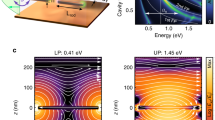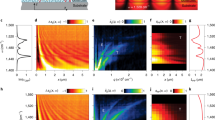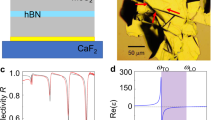Abstract
Vibrational ultrastrong coupling, where the light–matter coupling strength is comparable to the vibrational frequency of molecules, presents new opportunities to probe the interactions between molecules and zero-point fluctuations, harness cavity-modified chemical reactions and develop novel devices in the mid-infrared spectral range. Here we use epsilon-near-zero nanocavities filled with a model polar medium (SiO2) to demonstrate ultrastrong coupling between phonons and gap plasmons. We present classical and quantum-mechanical models to quantitatively describe the observed plasmon–phonon ultrastrong coupling phenomena and demonstrate a modal splitting of up to 50% of the resonant frequency (normalized coupling strength η > 0.25). Our wafer-scale nanocavity platform will enable a broad range of vibrational transitions to be harnessed for ultrastrong coupling applications.
This is a preview of subscription content, access via your institution
Access options
Access Nature and 54 other Nature Portfolio journals
Get Nature+, our best-value online-access subscription
$29.99 / 30 days
cancel any time
Subscribe to this journal
Receive 12 print issues and online access
$209.00 per year
only $17.42 per issue
Buy this article
- Purchase on Springer Link
- Instant access to full article PDF
Prices may be subject to local taxes which are calculated during checkout



Similar content being viewed by others
Data availability
The data that support the plots within this paper and other findings of this study are available from the corresponding authors upon reasonable request.
References
Törmä, P. & Barnes, W. L. Strong coupling between surface plasmon polaritons and emitters: a review. Rep. Prog. Phys. 78, 013901 (2015).
Ebbesen, T. W. Hybrid light-matter states in a molecular and material science perspective. Acc. Chem. Res. 49, 2403–2412 (2016).
Pelton, M. Modified spontaneous emission in nanophotonic structures. Nat. Photon. 9, 427–435 (2015).
Luk’yanchuk, B. et al. The Fano resonance in plasmonic nanostructures and metamaterials. Nat. Mater. 9, 707–715 (2010).
Neubrech, F. et al. Resonant plasmonic and vibrational coupling in a tailored nanoantenna for infrared detection. Phys. Rev. Lett. 101, 157403 (2008).
Yoshie, T. et al. Vacuum Rabi splitting with a single quantum dot in a photonic crystal nanocavity. Nature 432, 200–203 (2004).
Reithmaier, J. P. et al. Strong coupling in a single quantum dot-semiconductor microcavity system. Nature 432, 197–200 (2004).
Aoki, T. et al. Observation of strong coupling between one atom and a monolithic microresonator. Nature 443, 671–674 (2006).
Liu, X. et al. Strong light–matter coupling in two-dimensional atomic crystals. Nat. Photon. 9, 30–34 (2015).
Benz, F. et al. Single-molecule optomechanics in ‘picocavities’. Science 354, 726–729 (2016).
Santhosh, K., Bitton, O., Chuntonov, L. & Haran, G. Vacuum Rabi splitting in a plasmonic cavity at the single quantum emitter limit. Nat. Commun. 7, 11823 (2016).
Runnerstrom, E. L. et al. Polaritonic hybrid-epsilon-near-zero modes: beating the plasmonic confinement vs propagation-length trade-off with doped cadmium oxide bilayers. Nano Lett. 19, 948–957 (2018).
Leng, H., Szychowski, B., Daniel, M.-C. & Pelton, M. Strong coupling and induced transparency at room temperature with single quantum dots and gap plasmons. Nat. Commun. 9, 4012 (2018).
Park, K.-D. et al. Tip-enhanced strong coupling spectroscopy, imaging, and control of a single quantum emitter. Sci. Adv. 5, eaav5931 (2019).
Schoelkopf, R. J. & Girvin, S. M. Wiring up quantum systems. Nature 451, 664–669 (2008).
Dunkelberger, A., Spann, B., Fears, K., Simpkins, B. & Owrutsky, J. Modified relaxation dynamics and coherent energy exchange in coupled vibration-cavity polaritons. Nat. Commun. 7, 13504 (2016).
Munkhbat, B., Wersäll, M., Baranov, D. G., Antosiewicz, T. J. & Shegai, T. Suppression of photo-oxidation of organic chromophores by strong coupling to plasmonic nanoantennas. Sci. Adv. 4, eaas9552 (2018).
Thomas, A. et al. Tilting a ground-state reactivity landscape by vibrational strong coupling. Science 363, 615–619 (2019).
Kockum, A. F., Miranowicz, A., Liberato, S. D., Savasta, S. & Nori, F. Ultrastrong coupling between light and matter. Nat. Rev. Phys. 1, 19–40 (2019).
Forn-Díaz, P., Lamata, L., Rico, E., Kono, J. & Solano, E. Ultrastrong coupling regimes of light-matter interaction. Rev. Mod. Phys. 91, 025005 (2019).
Romero, G., Ballester, D., Wang, Y. M., Scarani, V. & Solano, E. Ultrafast quantum gates in circuit QED. Phys. Rev. Lett. 108, 120501 (2012).
Johansson, J. R., Johansson, G., Wilson, C. M. & Nori, F. Dynamical Casimir effect in a superconducting coplanar waveguide. Phys. Rev. Lett. 103, 147003 (2009).
Wilson, C. M. et al. Observation of the dynamical Casimir effect in a superconducting circuit. Nature 479, 376–379 (2011).
Schwartz, T., Hutchison, J. A., Genet, C. & Ebbesen, T. W. Reversible switching of ultrastrong light-molecule coupling. Phys. Rev. Lett. 106, 196405 (2011).
Niemczyk, T. et al. Circuit quantum electrodynamics in the ultrastrong-coupling regime. Nat. Phys. 6, 772–776 (2010).
Jouy, P. et al. Transition from strong to ultrastrong coupling regime in mid-infrared metal-dielectric-metal cavities. Appl. Phys. Lett. 98, 231114 (2011).
George, J. et al. Multiple Rabi splittings under ultrastrong vibrational coupling. Phys. Rev. Lett. 117, 153601 (2016).
Scalari, G. et al. Ultrastrong coupling of the cyclotron transition of a 2D electron gas to a THz metamaterial. Science 335, 1323–1326 (2012).
Shelton, D. J. et al. Strong coupling between nanoscale metamaterials and phonons. Nano Lett. 11, 2104–2108 (2011).
Autore, M. et al. Boron nitride nanoresonators for phonon-enhanced molecular vibrational spectroscopy at the strong coupling limit. Light Sci. Appl. 7, 17172 (2018).
Lather, J., Bhatt, P., Thomas, A., Ebbesen, T. W. & George, J. Cavity catalysis by cooperative vibrational strong coupling of reactant and solvent molecules. Angew. Chem. Int. Ed. 58, 10635–10638 (2019).
Jin, X. et al. Reshaping the phonon energy landscape of nanocrystals inside a terahertz plasmonic nanocavity. Nat. Commun. 9, 763 (2018).
Muller, E. A. et al. Nanoimaging and control of molecular vibrations through electromagnetically induced scattering reaching the strong coupling regime. ACS Photonics 5, 3594–3600 (2018).
Baida, F. I., Belkhir, A., Labeke, D. V. & Lamrous, O. Subwavelength metallic coaxial waveguides in the optical range: role of the plasmonic modes. Phys. Rev. B 74, 205419 (2006).
Alù, A. & Engheta, N. Light squeezing through arbitrarily shaped plasmonic channels and sharp bends. Phys. Rev. B 78, 035440 (2008).
Yoo, D. et al. High-throughput fabrication of resonant metamaterials with ultrasmall coaxial apertures via atomic layer lithography. Nano Lett. 16, 2040–2046 (2016).
Liberal, I. & Engheta, N. Near-zero refractive index photonics. Nat. Photon. 11, 149–158 (2017).
Lindquist, N. C., Nagpal, P., McPeak, K. M., Norris, D. J. & Oh, S.-H. Engineering metallic nanostructures for plasmonics and nanophotonics. Rep. Prog. Phys. 75, 036501 (2012).
Garcia-Vidal, F. J., Martin-Moreno, L., Ebbesen, T. W. & Kuipers, L. Light passing through subwavelength apertures. Rev. Mod. Phys. 82, 729–787 (2010).
Born, M. & Huang, K. Dynamical Theory of Crystal Lattices (Oxford Univ. Press, 1988).
Hopfield, J. J. Theory of the contribution of excitons to the complex dielectric constant of crystals. Phys. Rev. 112, 1555–1567 (1958).
Quattropani, A., Andreani, L. C. & Bassani, F. Quantum theory of polaritons with spatial dispersion: exact solutions. Il Nuovo Cimento D 7, 55–69 (1986).
Ciuti, C., Bastard, G. & Carusotto, I. Quantum vacuum properties of the intersubband cavity polariton field. Phys. Rev. B 72, 115303 (2005).
Todorov, Y. & Sirtori, C. Intersubband polaritons in the electrical dipole gauge. Phys. Rev. B 85, 045304 (2012).
Kéna-Cohen, S., Maier, S. A. & Bradley, D. D. C. Ultrastrongly coupled exciton-polaritons in metal-clad organic semiconductor microcavities. Adv. Opt. Mater. 1, 827–833 (2013).
Cirio, M., De Liberato, S., Lambert, N. & Nori, F. Ground state electroluminescence. Phys. Rev. Lett. 116, 113601 (2016).
Kockum, A. F., Miranowicz, A., Macrì, V., Savasta, S. & Nori, F. Deterministic quantum nonlinear optics with single atoms and virtual photons. Phys. Rev. A 95, 063849 (2017).
Garziano, L. et al. One photon can simultaneously excite two or more atoms. Phys. Rev. Lett. 117, 043601 (2016).
Kockum, A. F., Macrì, V., Garziano, L., Savasta, S. & Nori, F. Frequency conversion in ultrastrong cavity QED. Sci. Rep. 7, 5313 (2017).
Kischkat, J. et al. Mid-infrared optical properties of thin films of aluminum oxide, titanium dioxide, silicon dioxide, aluminum nitride, and silicon nitride. Appl. Opt. 51, 6789–6898 (2012).
Acknowledgements
We thank T. W. Ebbesen for helpful comments. This research was supported by grants from the US National Science Foundation (ECCS 1809240 to D.Y., D.A.M., S.-H.O.; ECCS 1809723 to I.-H.L., S.-H.O.) and the Samsung Global Research Outreach (GRO) Program (to S.-H.O.). F.d.L.-P. and L.M.-M. acknowledge financial support from the Spanish Ministry of Economy and Competitivity through projects MAT2017-88358-C3-1-R and MAT2017-88358-C3-2-R and the Aragón Government project Q-MAD. M.P. acknowledges support from the US National Science Foundation (NSF DMR-1905135). M.B.R. acknowledges funding from the US National Science Foundation (NSF CHE-1709822). J.D.C. was supported by the Office of Naval Research Grant N00014-18-12107. S.-H.O. further acknowledges support from the Sanford P. Bordeau Chair in Electrical Engineering at the University of Minnesota.
Author information
Authors and Affiliations
Contributions
D.Y. and S.-H.O. conceived the project and designed experiments. D.Y. performed device design, fabrication and measurements. F.d.L.-P. and L.M.-M. developed theories and performed numerical calculations. D.A.M. and I.-H.L. performed computer simulations. D.Y., F.d.L.-P., M.P., D.A.M., I.-H.L., M.B.R., J.D.C., L.M.-M. and S.-H.O. analysed the results. All authors contributed to interpretation of the results and wrote the paper together.
Corresponding authors
Ethics declarations
Competing interests
The authors declare no competing interests.
Additional information
Publisher’s note Springer Nature remains neutral with regard to jurisdictional claims in published maps and institutional affiliations.
Supplementary information
Supplementary Information
Supplementary Figs. 1–9, Sections 1–11 and Tables 1 and 2.
Rights and permissions
About this article
Cite this article
Yoo, D., de León-Pérez, F., Pelton, M. et al. Ultrastrong plasmon–phonon coupling via epsilon-near-zero nanocavities. Nat. Photonics 15, 125–130 (2021). https://doi.org/10.1038/s41566-020-00731-5
Received:
Accepted:
Published:
Issue Date:
DOI: https://doi.org/10.1038/s41566-020-00731-5
This article is cited by
-
High-quality nanocavities through multimodal confinement of hyperbolic polaritons in hexagonal boron nitride
Nature Materials (2024)
-
Hyperbolic whispering-gallery phonon polaritons in boron nitride nanotubes
Nature Nanotechnology (2023)
-
In-plane hyperbolic polariton tuners in terahertz and long-wave infrared regimes
Nature Communications (2023)
-
Dynamic construction of refractive index-dependent vibrations using surface plasmon-phonon polaritons
Nature Communications (2023)
-
Coupling of Epsilon-Near-Zero Mode to Mushroom-Type Metamaterial for Optimizing Infrared Suppression and Radiative Cooling
Photonic Sensors (2023)



